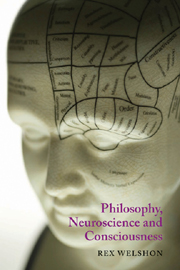Book contents
- Frontmatter
- Contents
- Preface
- Introduction
- PART I PHILOSOPHY AND CONSCIOUSNESS
- PART II NEUROSCIENCE AND CONSCIOUSNESS
- PART III PHILOSOPHY, NEUROSCIENCE AND CONSCIOUSNESS
- 9 Measurement, localization, models and dissociation
- 10 Correlates, realizers and multiple realization
- 11 Microphysical reduction, overdetermination and coupling
- 12 Embodied and embedded consciousness
- Concluding semi-scientific postscript
- Appendix Functional neuroanatomy
- Notes
- Bibliography
- Index
11 - Microphysical reduction, overdetermination and coupling
from PART III - PHILOSOPHY, NEUROSCIENCE AND CONSCIOUSNESS
- Frontmatter
- Contents
- Preface
- Introduction
- PART I PHILOSOPHY AND CONSCIOUSNESS
- PART II NEUROSCIENCE AND CONSCIOUSNESS
- PART III PHILOSOPHY, NEUROSCIENCE AND CONSCIOUSNESS
- 9 Measurement, localization, models and dissociation
- 10 Correlates, realizers and multiple realization
- 11 Microphysical reduction, overdetermination and coupling
- 12 Embodied and embedded consciousness
- Concluding semi-scientific postscript
- Appendix Functional neuroanatomy
- Notes
- Bibliography
- Index
Summary
The rush to image the neural correlates of conscious events can look more than a little like high-tech phrenology (Uttal 2001). Although feeling bumps on the skull and producing cranial maps has been replaced by a lot of coloured pictures and intracranial neural maps, the drive to reduce consciousness to something small remains the same. Still, it would be surprising were there nothing at all to the correlational evidence. What the neuroscientific evidence suggests instead is that conscious properties cannot be instantiated outside a neural environment. Those wary of even this much optimism counter that subjective perspectivity, intentionality and qualitative character are irreducible to anything neural. While we may not know exactly what the nature of these conscious properties is, reducing them to properties or neural assembly properties is mistaken.
Since conscious properties are higher-order properties, they are implemented by mechanisms or processes of some sort. But what sorts of mechanisms are conscious properties implemented by? This chapter investigates two arguments against the claim that neural mechanisms and their properties implement conscious properties. According to the first, neural mechanisms are too big and their properties not sufficiently lower-order; according to the second, neural mechanisms are not big enough and their properties not sufficiently higher-order. Several counterarguments to microphysical reduction are presented. Developing some of them takes time and entails defending emergent causation against the charge of overdetermination. In the latter third of the chapter, vehicle externalism is picked back up, and its use in arguments for rejecting computational representationalism is examined in greater detail. This examination continues in Chapter 12.
- Type
- Chapter
- Information
- Philosophy, Neuroscience and Consciousness , pp. 243 - 266Publisher: Acumen PublishingPrint publication year: 2010



